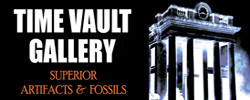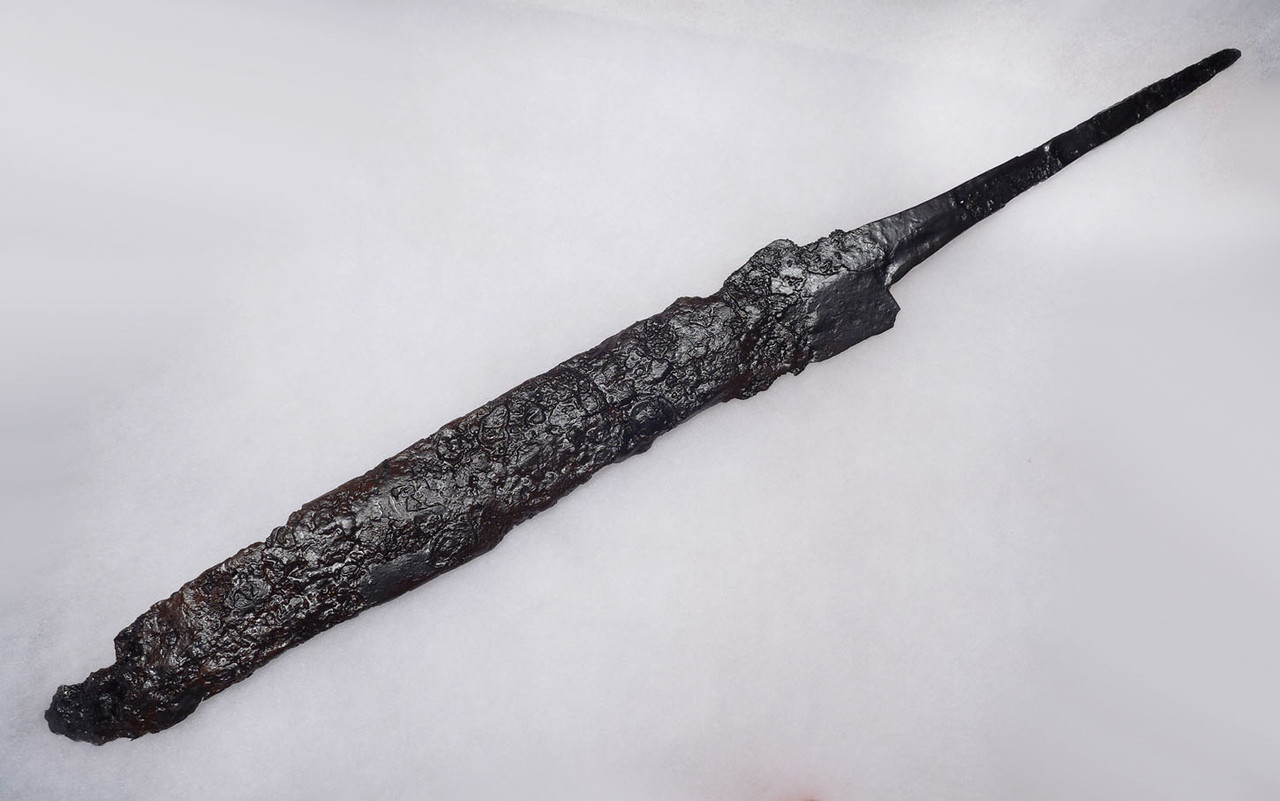Product Description
This is an EXTREMELY RARE ancient iron SHORT SWORD of the Celtic tribes that once occupied what is now western Germany. It is a true museum-class specimen simply due to its sheer scarcity and degree of completeness. The nature of the corrosion shows it was once buried in a scabbard or sheath that accelerated the corrosion on the part that would have been covered - just below the top of the blade edge near the handle, to the end of the blade. The former handle would have covered the long tang, and part of the top of the blade. This area is extremely well preserved considering the damp soil of western Europe, and this being iron over 2000 years old. The main part of the blade is poorly preserved but virtually complete, nevertheless. This is taken into account in the price for if the blade was better preserved, this piece would be MANY times the price being offered. For advanced collectors that can grasp the true rarity of this offer, the condition should not put you off as in 32 years of business, this is the only Celtic iron short sword from western Europe, that we have handled or offered for sale! There will be no others that we will offer as this came from a large multi-generation German collection that is unlike any other we have seen. Private sales of rare objects like this can only come from old collections as laws in Europe have forbid searching or digging for artifacts for nearly 40 years now.
Ancient Iron Age swords from the Celts are among the rarest weapons of the ancient world. They were prestige objects of the highest level and required a great deal of wealth to acquire, most often out of the reach of the common citizen of the day where axes were the most common weapon. Their scarcity in ancient times carries forward today where complete specimens are RARELY offered for sale. Ancient Celtic objects are rare and seldom found in collections.
With the spread of the La Tene culture at the 5th century BC, iron swords had completely replaced bronze all over Europe. These swords eventually evolved into, among others, the Roman gladius and spatha, and the Greek xiphos and the Germanic sword of the Roman Iron Age, which evolved into the Viking sword in the 8th century. There are two kinds of Celtic sword. The most common is the "long" sword, which usually has a stylised anthropomorphic hilt made from organic material, such as wood, bone, or horn. These swords also usually had an iron plate in front of the guard that was shaped to match the scabbard mouth. The second type is a "short" sword with either an abstract or a true anthropomorphic hilt of copper alloy. Scabbards were generally made from two plates of iron, and suspended from a belt made of iron links. Some scabbards had front plates of bronze rather than iron. This was more common on Insular examples than elsewhere; only a very few Continental examples are known.
Unlike most metal artifacts sold on the market that are untreated and uncleaned, our specimens our properly cleaned, inspected and conserved in our museum conservation lab prior to being offered for sale to our clients. If ancient metal is NOT treated and stabilized correctly, IT WILL CONTINUE TO DISINTEGRATE AND CORRODE, AND COULD EVENTUALLY FALL APART.
SEE MORE ANCIENT CELTIC ARTIFACTS
HISTORY
Around 2000 B.C., barbarian Celtic tribes invaded Europe. They first inhabited regions across Eastern Europe now known as Hungary, Bulgaria, Romania and the Balkans. During the Bronze Age, they move westward and by the Iron Age in the 8th to 5th centuries BC, these tribes make their homes in what is now southwest Germany, eastern France and parts of Switzerland and Austria. This era is known as the Hallstat period named after a Celtic archaeological type-site in a lakeside village in Austria. After that, in the La Tene period, western Europe becomes heavily occupied by the Celts as they invade much of Germany, France, the Iberian Peninsula (Spain and Portugal), the British Islands and Ireland. After this time, Celtic tribes spread eastward again, moving into northern Italy, Bohemia, Silesia, the Balkans and even into present day Turkey with a tribe called the Galatians establishing a Celtic city called Galatia. During the 1st century BC, the Celts were at the height of their power and were the dominant ethnic group in much of Europe, even ruling over the Germanic tribes. Among the many military victories the ancient Celts can lay claim to are the sacking of the cities of Rome and Delphi.
The Celts were largely a decentralized military aristocracy made up of independent chieftains ruling various geographical regions. They were famous to fight just for the sake of fighting and often, they were employed as mercenaries of the great armies of ancient times. Along with their reputations of chivalry, courage and maniacal bravery, their more aggressive tendencies were offset by a great sensitivity to the arts and philosophy. Highly unusual at the time, the Celts viewed both men AND women with equality, holding women in high regard with their matriarchal religion.
One of the famous works the Celts were known for was their masterful works in metalsmithing. Spectacular works can be found all over Europe left behind by Celtic masters in gold, silver, bronze and later, in iron. Much of the influence of Bronze Age European metal ornament lends itself to the influence Celtic master craftspeople.
WARNING: There is an ALARMING number of fake and altered ancient artifacts on the market. As fine quality intact, original specimens become more scarce and techniques have become more sophisticated to fake these artifacts. We have personally handled numerous extremely well-done fakes with convincing patinas that could fool most people. The degree to which the fakers have been able to replicate patina to disguise their work requires an expert examination by highly experienced individuals. Like all rare collectibles, fakes plague the market. We subject every piece we offer to a full analysis, cleaning and conservation process in our on-site lab. How many dealers do this or have any experience in operating their own lab? The procedures we put each piece through are the same as we do for those specimens destined for museums and the same procedures as the best museums perform on their own collections. Deal only with sources that are extremely knowledgeable in forgeries or altered pieces and get a written guarantee of authenticity that has no conditions or expiration period. We include this guarantee in writing with every item we sell. All purchases should include from the dealer, a written guarantee of authenticity with unconditional and lifetime return policies regarding such guarantee.
 US DOLLAR
US DOLLAR
 EURO
EURO
 AUSTRALIAN DOLLAR
AUSTRALIAN DOLLAR
 CANADIAN DOLLAR
CANADIAN DOLLAR
 POUND STERLING
POUND STERLING














